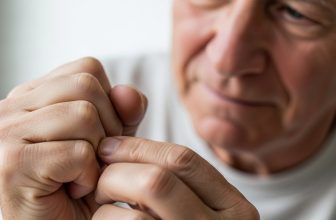
Trauma and 3 Key Facts Showing How powerful Healing Can Stop Dupuytrens
Introduction
Many patients notice that Dupuytren’s contracture seems to appear after a cut, sprain, or fracture of the hand or trauma. The timing can feel too close to be coincidence, leading many to wonder: Can trauma actually cause Dupuytren’s disease?
While trauma alone doesn’t create the condition, research shows that injury can act as a spark—triggering fibrosis in individuals who are already genetically or metabolically predisposed. In other words, the injury itself doesn’t “cause” Dupuytren’s, but it may awaken an underlying tendency toward abnormal healing.
What the Studies Show
Several studies have explored the link between hand trauma and the later development of Dupuytren’s. One key investigation published in Hand Surgery Europe found that individuals who experienced a hand injury or surgery had a significantly higher rate of Dupuytren’s diagnosis within the following two years compared to uninjured controls.
The findings suggest that trauma, whether from an accident, surgical incision, or repetitive strain, may serve as a triggering event. Even small, repetitive stresses—like hammering, gripping tools, or sports-related impacts—can stimulate fibroblast activity in already sensitive tissue.
In susceptible individuals, this can start a self-perpetuating cycle of collagen overproduction, leading to the thick cords and nodules characteristic of Dupuytren’s.
The Mechanism: How Trauma Sparks Fibrosis
After any injury, the body naturally initiates an inflammatory cascade to repair damaged tissue. This involves the release of signaling molecules such as TGF-β (Transforming Growth Factor Beta), cytokines, and growth factors that activate fibroblasts—the collagen-producing cells responsible for rebuilding connective tissue.
In most people, once the wound heals, fibroblast activity quiets down and collagen remodeling stops.
However, in those with a genetic predisposition or metabolic imbalance (such as diabetes or chronic inflammation), fibroblasts may remain overactive, continuing to deposit collagen long after healing should have ended.
Over time, this results in:
-
Excess collagen buildup that forms thicker-than-normal scar tissue.
-
Stiff, fibrotic cords that pull on tendons and skin.
-
Progressive contracture of the fingers, especially the ring and little fingers.
Essentially, the injury acts as a catalyst, but the underlying “fuel” for Dupuytren’s is already present in the body.
Risk Modifiers: Why Some People Develop It and Others Don’t
Not everyone who injures their hand develops Dupuytren’s, and that’s because the condition depends on multiple factors.
Genetics play the strongest role—people with Northern European ancestry or a family history of Dupuytren’s are at much higher risk. However, metabolic and lifestyle factors such as diabetes, smoking, and heavy alcohol use can amplify this genetic risk.
These factors all contribute to impaired circulation, oxidative stress, and chronic inflammation, which prime fibroblasts to overreact.
So, when an injury occurs, the healing process in these individuals becomes exaggerated—normal scar formation transforms into pathologic fibrosis.
This explains why one person heals from a minor hand injury without issue, while another begins noticing lumps or tightness in the palm months later.
How to Protect Yourself After Injury
While you can’t change your genes, you can influence how your body heals after trauma. Here are some practical steps to lower the risk of abnormal fibrosis:
-
Keep injuries clean and immobilized until fully healed to prevent infection and reduce inflammation.
-
Follow through with physical or occupational therapy once cleared, including gentle stretching and massage to maintain tissue mobility.
-
Support anti-inflammatory nutrition, emphasizing foods rich in omega-3s, leafy greens, and antioxidants to reduce oxidative stress.
-
Stay hydrated and maintain healthy blood flow through light movement once recovery allows.
-
Avoid repetitive gripping or strain during the healing phase, as this can reactivate fibroblast activity.
These steps help encourage balanced tissue repair rather than excessive scarring.
The Bigger Picture
Researchers now view Dupuytren’s not as a purely local hand disease, but as part of a systemic tendency toward fibrosis. This means that the same biological processes affecting the hand may also influence other connective tissues in the body.
For people with known risk factors—like diabetes, smoking, or family history—preventive care after injuries becomes especially important. Early management can make a significant difference in long-term outcomes.
Conclusion
Trauma by itself doesn’t cause Dupuytren’s contracture, but in people already primed for fibrosis, it can ignite the process. The good news is that proper injury care, healthy lifestyle choices, and inflammation control can lower the risk of abnormal scarring and potentially delay disease onset.
By treating even small hand injuries with care and attention, you’re not just healing a wound—you’re protecting your future hand function.
Legal & Medical Disclaimer
This content is for educational purposes only and not a substitute for medical advice. Consult a licensed clinician for any injury or symptoms. Dupuytren’s Solutions is an educational platform to complement professional care; results may vary.
Call to Action
Learn how to protect healing tissue and reduce fibrosis risk at DupuytrensSolutions.com. Join our community for rehab guides and success stories: facebook.com/groups/dupuytrenssolutionsandhealth.
Attribution
(CC BY 4.0) Adapted from Reilly RM et al. Trauma and Dupuytren’s Contracture. Hand (Surg Eur). 2017; 42(5): 481–489. Licensed under Creative Commons Attribution 4.0. Source.





